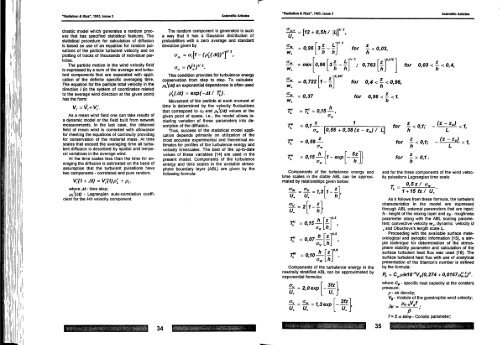Russian Issue 3 - Harvard University Department of Physics
Russian Issue 3 - Harvard University Department of Physics
Russian Issue 3 - Harvard University Department of Physics
You also want an ePaper? Increase the reach of your titles
YUMPU automatically turns print PDFs into web optimized ePapers that Google loves.
"Radiation & Risk", 1993, issue 3<br />
chastic model which generates a random process<br />
that has specified statistical features. The<br />
statistical procedure for calculation <strong>of</strong> diffusion<br />
is based on use <strong>of</strong> an equation for random pulsations<br />
<strong>of</strong> the particle turbulent velocity and on<br />
plotting <strong>of</strong> tracks <strong>of</strong> thousands <strong>of</strong> individual particles.<br />
The particle motion in the wind velocity field<br />
is expressed by a sum <strong>of</strong> the average and turbulent<br />
components that are separated with application<br />
<strong>of</strong> the definite specific averaging time.<br />
The equation for the particle total velocity in the<br />
direction / On the system <strong>of</strong> coordinates related<br />
to the average wind direction at the given point)<br />
has the form:<br />
v,=vl+v;.<br />
As a mean wind field one can take results <strong>of</strong><br />
a dynamic model or the field built from network<br />
measurements. In the last case, the obtained<br />
field <strong>of</strong> mean wind is corrected with allowance<br />
for meeting the equations <strong>of</strong> continuity providing<br />
for conservation <strong>of</strong> the material mass. At time<br />
scales that exceed the averaging time ail turbulent<br />
diffusion is described by spatial and temporal<br />
variations in the average wind.<br />
At the time scales less than the time for averaging<br />
the diffusion is estimated on the basis <strong>of</strong><br />
assumption that the turbulent pulsations have<br />
two components - correlated and pure random.<br />
v;(t + At) = v;(t)P'L+p„<br />
where At - time step;<br />
pt(At) - Lagrangian auto-correlation coefficient<br />
for the Mh velocity component.<br />
34<br />
Scientific Articles<br />
The random component is generated is such<br />
a way that it has a Gaussion distribution <strong>of</strong><br />
probabilities with a zero average and standard<br />
deviation given by<br />
This condition provides for turbulence energy<br />
conservation from step to step. To calculate<br />
PL (At) an exponential dependence is <strong>of</strong>ten used<br />
p'L(At)=exp(-At/ rL).<br />
Movement <strong>of</strong> the particle at each moment <strong>of</strong><br />
time is determined by the velocity fluctuations<br />
that correspond to CT/ and pi!(At) values at the<br />
given point <strong>of</strong> space, i.e., the model allows including<br />
variation <strong>of</strong> these parameters into description<br />
<strong>of</strong> the diffusion.<br />
Thus, success <strong>of</strong> the statistical model application<br />
depends primarily on utilization <strong>of</strong> the<br />
most accurate experimental and theoretical estimates<br />
for pr<strong>of</strong>iles <strong>of</strong> the turbulence energy and<br />
velocity timescaies. The best <strong>of</strong> the up-to-date<br />
values <strong>of</strong> these variables [14] are used in the<br />
present model. Components <strong>of</strong> the turbulence<br />
energy and time scales in the unstable atmosphere<br />
boundary layer (ABL) are given by the<br />
following formula:<br />
'•r<br />
"Radiation & Risk", 1993, issue 3 Scientific Articles<br />
^ = [12 + 0,5h/ \l\X\<br />
^-<br />
w.<br />
= 0,96<br />
h<br />
-(1/3<br />
h<br />
for ~ < 0,03,<br />
h<br />
^- =/n/n 0 , 9 6 ^ - M ; 0,763<br />
r 7-\ 0 - 207<br />
= ° ' 7 2 T - i<br />
= 0,37<br />
7? = VL=0,15^-,<br />
for 0,4 < — < 0,96,<br />
h<br />
for 0,96

















